The slim-line 9mm is the most popular concealed-carry handgun in America, according to polls and gun sales. The type is compact enough for good concealment, reliable in good examples, and powerful enough for personal defense, while not generating so much recoil as to provide a daunting proposition in training. It is not surprising, then, that makers are introducing new models to compete in this market. While the field seems crowded, this is good for the consumer, who now has a broad choice. One small detail or the other may sway the shooter, and the final pick is a handgun that suits their needs and style well. With this in mind we tested three 9mm Luger handguns:
- The Ruger LC9s 3260, $437, is a proven model with certain upgrades, including a tastefully engraved slide;
- The Beretta APX Carry JAXN920, $398, is a single-stack version of the double-column-magazine Beretta APX; and
- The Bond Arms Bullpup 9, $904, is a new and improved rendition of the Boberg 9mm pistol.
We used four loads to test the three handguns. Two of the ammo choices are on the Bond Arms list of recommended self-defense and target ammo listed on the company’s website. These were the Winchester 115-grain full-metal-jacket round and the Federal 124-grain HST fodder. A load not listed on the Bond Arms site, but which provided good function, is the Black Hills Ammunition 124-grain jacketed hollow point.
We also used a +P loading in later testing for function. After testing the standard-pressure loads, we fired a last run on the combat range with a +P load, the Black Hills Ammunition 100-grain Honey Badger, which sells for $27.62 per 20 rounds at TargetSportsUSA.com. At 1300 fps, this load produced heavier recoil than the standard-pressure loads, which is to be expected. Though Bond Arms does not recommend this load in the Bullpup 9, the Honey Badger was reliable in all three in limited shooting, two magazines per pistol.
After all this shooting, here is what we found out about each gun:
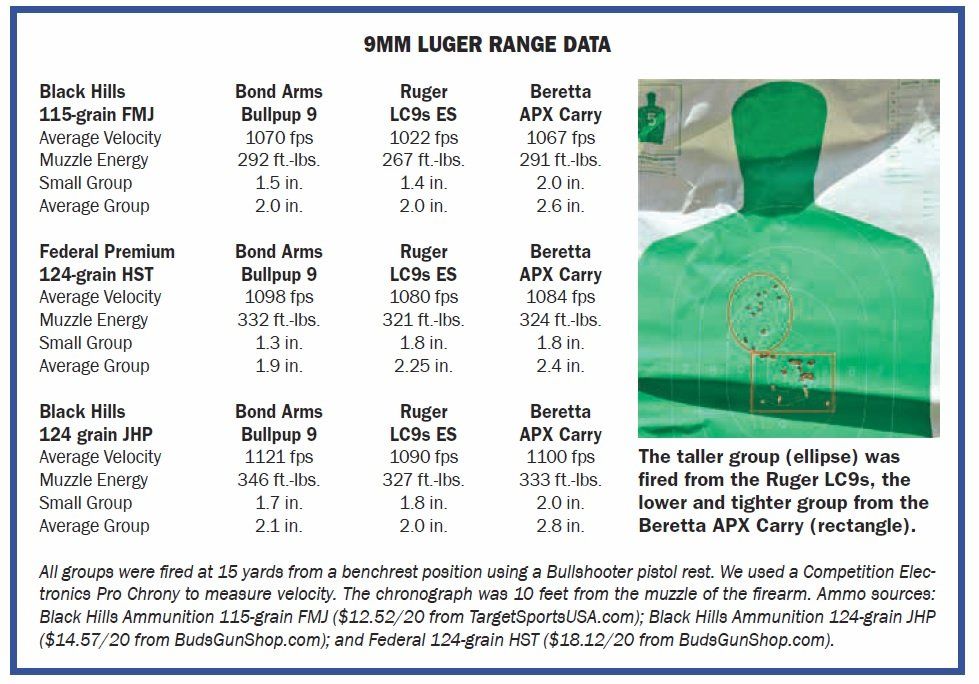
Beretta APX Carry JAXN920 9mm Luger, $398
GUN TESTS GRADE: A (BEST BUY)
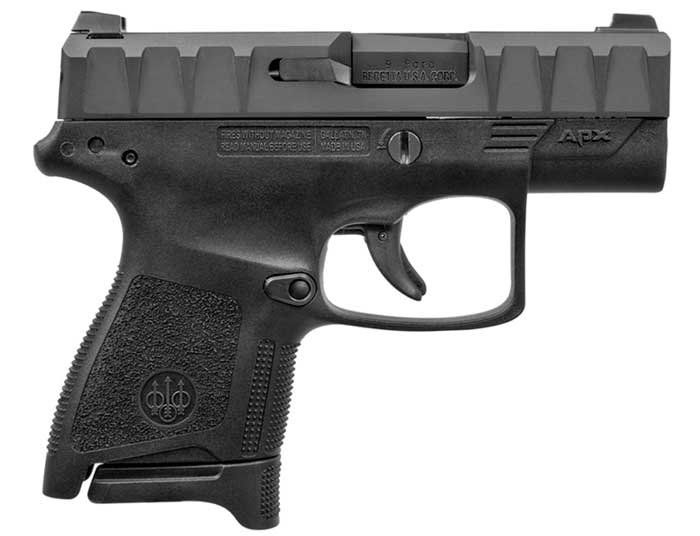
The Beretta APX Carry builds upon the proven Nano and borrows from the full-size and compact APX pistols. The result is a desirable combination of features, including good reliability and practical accuracy.
Action Type |
Locked breech, striker fired, double action only |
Overall Length |
5.63 in. |
Overall Height |
4.16 in. |
Maximum Width |
1.0 in. |
Weight Unloaded |
19.8 oz. |
Weight Loaded |
22.4 oz. |
Slide Material |
Forged Steel |
Slide Retraction Effort |
16.0 lbs. |
Receiver Material |
Polymer |
Finish |
Black |
Front Strap Height |
1.3 in. |
Back Strap Height |
3.0 in. |
Barrel Length |
3.0 in. |
Grip Thickness (Maximum) |
0.9 in. |
Grip Circumference |
5.6 in. |
Magazine |
(1) 6- and (1) 8-round |
Rear Sight |
Drift adjustable |
Front Sight |
Removable front post |
Sight Radius |
4.5 in. |
Trigger Pull Weight |
5.7 lbs. |
Trigger Span |
2.6 in. |
Safety |
Lever in trigger, firing-pin block |
Warranty |
1-year limited |
Telephone |
(800) 573-4445 |
Website |
Beretta.com |
Made In |
USA |
This is a recent price at ClassicFirearms.com. Concealed-carry permits are on the rise; something we at Gun Tests and freedom-loving Americans applaud and support. Another fact that is good to know is that the majority of new permit holders are choosing capable handguns. Few are 32 ACPs and 380 ACPs. The most popular choices are 9mm Luger chamberings (aka 9x19mm, 9mm Para). The slim 9mm has rewritten the rules of concealed carry. A smaller handgun may be carried with confidence due to new ammunition developments, without resorting to a heavy-recoiling 45 ACP or 357 Magnum. The 9mm isn’t a 45 ACP in terms of terminal performance, but the 9mm is a baseline for personal defense. The original Beretta APX is a Glock 17-size handgun designed for military competition. The APX Compact is a Glock 19-size handgun. The new Beretta APX Carry competes with the Smith & Wesson Shield and Glock 43 as well as the rest of the handguns tested. So, Beretta had a design to work with when perfecting the Beretta APX Carry.
The Beretta APX is obviously based on the Beretta Nano, although the APX is slightly larger. The sights are better than the Nano’s, and the APX features a slide lock, while the Nano does not. The APX features a conventional striker-fired action. The double-action-only trigger pulls the striker to the rear against spring pressure after the striker has been prepped by the slide’s action. The trigger action is deceptively light in feel. It feels like 5.5 pounds, a Glock standard, but breaks against the Lyman trigger-pull gauge at 6.2 pounds. Reset is crisp. A rapid trigger reset is sometimes a greater aid in combat shooting than a lighter trigger action. A lever set into the trigger prevents lateral discharge. Coupled with good sights, the trigger action provided good performance in the combat run.
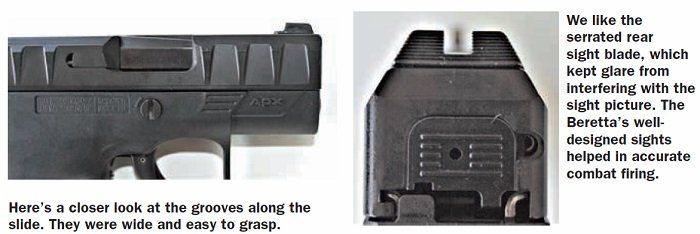
Elsewhere, we had no problem executing speed loads. The Beretta is supplied with two magazines, reasonable for the price. The pistol is supplied with a flush-fit 6-round magazine and an extended 8-round magazine. We expected a difference in handling. The difference was not as profound as we thought. The 6-round flush-fit magazine is ideal for pocket carry, given a larger pocket such as crews and carried in a Swaprig crews-type pocket holster. With the 8-round magazine, the footprint remains small when the handgun was carried in a Galco Stow-and-Go inside-the-waistband holster. These two magazines offer versatility. The pistol’s grip treatment offers a good balance of adhesion and abrasion. The pistol also features a slide filled with cocking serrations. These serrations work well, but they are not sharp and don’t hang on clothing or holsters. While we did not usually use the forward serrations, they worked well when we tried them out. They may be better referred to as cocking grooves.
During the combat-firing stages, the pistol fired low. We corrected that by maintaining a heavy grip. Polymer-frame pistols with a steel slide sometimes fire low if the shooter fires too quickly or does not keep a firm grip. Each handgun must be learned. By the end of the firing stage, we were doing better with center hits on each run.
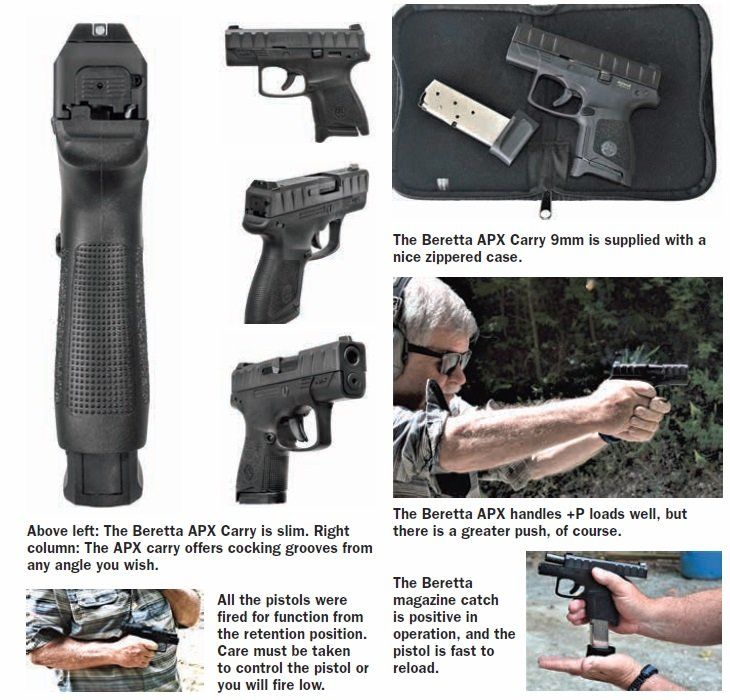
There are no malfunctions of any type in our notes. We split the firing time between the two magazines, turning in generally equal results with either. The pistol never failed to feed, chamber, fire, or eject. During the combat course, the pistol was comparable or superior to the other handguns. Each gave a good showing in fast combat shooting.
On the benchrest, the Beretta APX Carry posted less absolute accuracy than the Bond Arms Bullpup 9 or the Ruger LC9s Engraved. This is despite the pistol’s slight advantage over the other two in combat shooting drills. Striker-fired pistols are often easier to manage.
Our Team Said: The Beretta APX Carry pistol earns high marks. We feel it is the Best Buy of the test. We based this on faultless reliability, excellent sights, good tactical cocking grooves, superior combat shooting, and acceptable, if middle of the road, paper accuracy.
Bond Arms Bullpup 9 9mm Luger, $904
GUN TESTS GRADE: A-
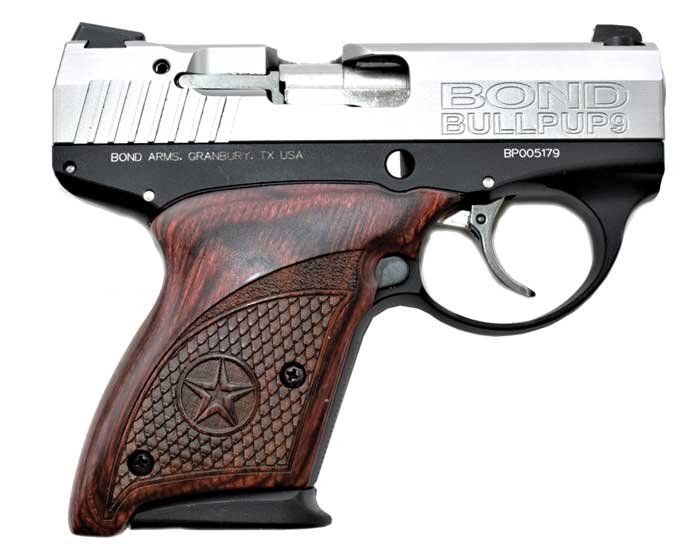
The Bond Arms Bullpup is an interesting design. The pistol features a rotating barrel with two locking lugs that lock into the slide and one into the locking block. The pistol does not lock open on the last shot, but may be locked open by rotating the takedown lever from the 3 o’clock to the 6 o’clock position. Unlike on the Boberg pistol, these magazines drop free. While the pistol is impressive on accuracy and reliability, this isn’t a handgun for the casual shooter.
Action Type |
Rotating barrel operated, locked breech, hammer-fired, double action only |
Overall Length |
5.1 in. |
Overall Height |
4.2 in. |
Maximum Width |
0.96 in. |
Weight Unloaded |
18.6 oz. |
Weight Loaded |
21.2 oz. |
Slide Material |
Stainless forged steel |
Slide Retraction Effort |
10.0 lbs. |
Receiver Material |
Aluminum |
Finish |
Black |
Front Strap Height |
1.75 in. |
Back Strap Height |
2.75 in. |
Barrel Length |
3.35 in. |
Grip Thickness (Maximum) |
1.2 in. |
Grip Circumference |
5.3 in. |
Magazine |
(4) 7 round |
Rear Sight |
Drift adjustable |
Front Sight |
Dovetail post, drift adjustable |
Sight Radius |
4.0 in. |
Trigger Pull Weight |
7.0 lbs. |
Trigger Span |
2.82 in. |
Safety |
No manual device |
Warranty |
3-year limited |
Telephone |
(817) 573-4445 |
Website |
BondArms.com |
Made In |
USA |
This was a recent price at BudsGunShop.com. The Bond Arms Bullpup 9 is a unique pistol in many ways. It owes little to preceding designs, save for the now-out-of-production Boberg XR 9 pistol. Bond Arms purchased the rights to the Boberg XR 9 and apparently the machinery. The Boberg had several problems, not the least of which was its cost. No matter how good the design or performance, the Boberg 9mm’s purchase price at about $1300 limited sales to a well-heeled few.
There were also function problems related to the design. Like many rotating-barrel handguns, the Boberg demanded heavy lubrication on the barrel and rotating block for reliable function. Bond Arms has made legitimate improvement in the design and lowered the price tag to a list of less than a thousand dollars. The actual price is as low as a few bucks under $900, with the pistol in stock at BudsGunShop.com for $904 as of late June. The Bullpup 9mm is a single-column magazine 9mm. There the resemblance to any other handgun ends.
The Bond Arms Bullpup 9 pistol is identical in dimension and operation to the original Boberg 9. The design uses a rotating barrel. This is unusual in a small handgun. The full-size Beretta Storm, the Beretta/Stoeger Cougar, and the out-of-production Mauser M2 use the rotating-barrel system. Recoil is controlled by this system in a manner that may limit recoil. On the other hand, rotating barrel handguns in general demand frequent lubrication to remain functional. When Bond Arms redesigned some particulars, they discovered and adopted a process for coating the barrel locking lugs and locking block. This coating, in use on AR-15 rifles, eliminated much of the requirement for the pistol to be lubricated constantly. Another feature that is more unusual than the rotating barrel is the rear-feeding magazine. Most pistols feature a conventional magazine that stops the cartridge at the case rim with the bullet end pointed toward the opening feedway of the magazine. The front is open to allow the bullet end of the cartridge to feed from the magazine. The Bond Arms Bullpup 9 features a magazine that butts the nose into a stop at the front of the magazine, with the rear of the magazine open. There is no follower; the cartridges sit on top of the magazine spring. This rearward feeding magazine is necessary due to the design of the Bullpup, and it’s where the pistol gets its name. Although it isn’t a Bullpup in the usual sense of a bullpup-type rifle, it is as close as a pistol may get. The action sits ahead of the pistol chamber. With the magazine location and the chamber to the rear of the trigger, the pistol feeds by means of a device that grasps the cartridge-case rim and moves the cartridge to the rear. As the spent case is ejected, the feed rail moves the cartridge into the chamber, and the cartridge is fed into the chamber. The feed rail maintains its grasp on the cartridge case rim and ejects the spent cartridge case after firing.

The action is a double-action-only type. The trigger is quite smooth in operation. Initial trigger compression was 7.5 pounds. After the test period, which began with a new Bond Arms Bullpup and continued for several weeks as each rater took his time with the handgun, the pistol’s trigger press settled into a smooth 7.0 pounds. The trigger action had no creep, stacking, or backlash. This allows good trigger control. The sights are good examples of combat pistol sights, making for rapid sight alignment. The pistol features a steel slide and aluminum frame. The grips are well done, cut from a dense wood that appears to be either rosewood or cocobolo. They are nicely checkered. The original Boberg 9mm used plastic grips despite its $1300 price tag. A purpose of the Bullpup design is to make possible a full-length slide and barrel on a small frame. The result is a pistol that appears to have a very short barrel, but which actually has a 3.4-inch tube. There is no heavy recoil spring, but only a small spring that Bond Arms calls a slide-return spring. The slide-cocking serrations are more than adequate for easy slide racking.
The Bond Arms company supplies a list of recommended loadings. Since we must adhere to fuel requirements for an engine and operating instructions for a computer, this is reasonable. The list is by no means short; there are more than 30 practice and personal-defense loads listed. The problem isn’t feed reliability, but rather the strength of the case crimp on the bullet. A loading without an adequate-to-tight-taper crimp may have the bullet pulled from the cartridge case during the Bond Arms Bullpup’s unusual feed cycle. Even using the recommended loads, we discovered, on removing an unfired round from the chamber in several instances, there was a small but perceptible movement of the bullet forward. Conversely, it isn’t unusual for a bullet to be pressed into the cartridge slightly on meeting the feed ramp with some designs. The Bond Arms has the opposite concern. We never experienced a bullet moving forward enough to affect velocity or function.
The pistol is very well finished and well fitted. There were no tool marks. The pistol is delivered in a padded box and supplied with a total of four magazines. The design does not allow the slide to lock open on the last shot. The slide may be manually locked open by retracting the slide and rotating the takedown lever.
Takedown isn’t particularly complicated. The takedown lever is rotated fully, and the barrel and slide moved forward off the frame. The barrel and locking lug block are removed. There is a very thin recoil spring, which Bond Arms calls a slide-return spring. The rotating barrel absorbs most of the recoil of the slide. When reassembling the pistol, we ran into a snag. The senior rater is an experienced individual who has used many firearms. It took him some time to get the disassembled pistol back together. The second and third time, the breakdown was much simpler. Just the same, this isn’t a pistol for the casually interested. While we felt the new self-lubricating finish was effective, we properly lubricated the rotating barrel and locking block with Ballistol before beginning the evaluation. However, we did not add lubrication in firing more than 300 rounds in the Bullpup 9.
When loading the pistol, the shooter must add a quick snap or the loading rail may press the bullet nose under the chamber. This is addressed by properly racking the slide. Due to the rotating-barrel design, the slide is very easy to rack, perhaps the easiest 9mm slide to rack we have ever tested and handled. But be certain to bring the slide fully to the rear and allow it to load with a sharp snap.
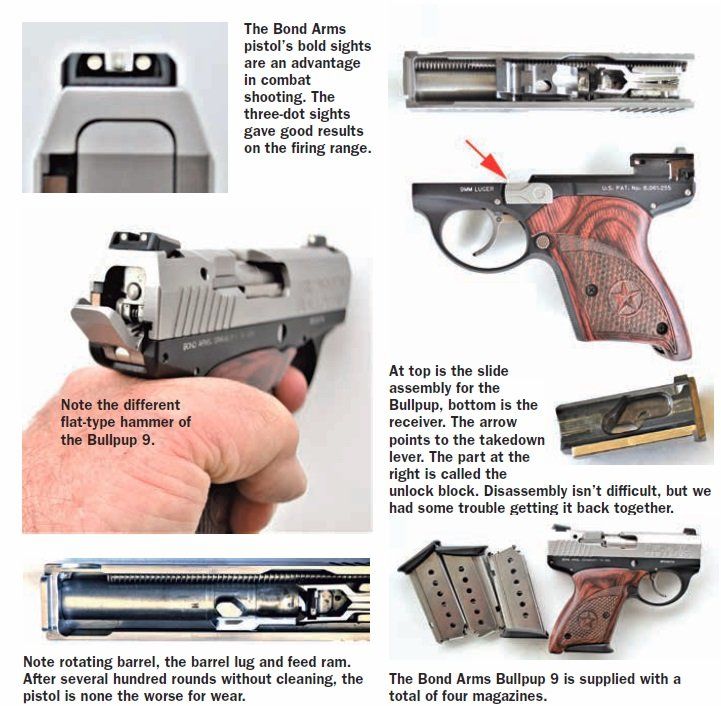
We began with the magazines loaded with the Winchester 115-grain FMJs. The smooth trigger face was comfortable and offered good leverage and control. The pistol came on target quickly. Control was excellent. The rotating barrel seems to control recoil. Despite the relatively light 17.5-ounce weight of the pistol, recoil was modest. As one of the raters noted, “This is a soft shooter.” Combat accuracy is good. We fired at 7, 10, and 15 yards in combat firing and also took more difficult shots at range objects and dirt clods on the berm at 20 to 25 yards, firing a total of 200 rounds of the Winchester 115-grain FMJs. The Bond Arms pistol fared better than the Ruger in combat firing tests, and while it outshot the Ruger in absolute accuracy, the Ruger isn’t a dog. The Bond Arms pistol simply exhibited superior accuracy, a neat trick for a double-action-only handgun shooting against a striker-fired handgun. We also fired 60 cartridges each of the Federal HST and Black Hills 124-grain JHP loads in each pistol. When firing from a solid benchrest firing position, the Bond Arms pistol gave good to excellent results. The trigger is smooth and resets at the end of its travel. Reset is distinct. By carefully working the action, we got excellent accuracy was realized. Groups at 15 yards were an average of well under 3.0 inches.
The pistol is the most expensive tested. The operating manual demands using the slingshot method to load the chamber. The pistol does not lock open on the last shot after firing. The magazines do not stick but drop free. In return, we have a pistol with excellent fit and finish, solid reliability, good combat accuracy, a very small footprint for concealed carry, and four magazines. The slide is easy to rack. The magazines are also easy to load.
Our Team Said: The Bullpup’s sole demerit as a personal-defense pistol is that the slide doesn’t lock open on the last shot. We rated the pistol down a half grade on this feature, which we admit some of the raters did not feel was a demerit for a pistol destined for short-range personal defense. Others felt it was a serious demerit and would not consider the handgun for personal defense as a result. The DAO trigger offers a second strike for those who like a second-strike capability; we prefer clearing the dud round. Considering the price of comparable small 9mm designs, such as the Kimber Solo and Springfield EMP, the price isn’t a demerit, but neither is it attractive to the average shooter.
Ruger LC9s Engraved Slide 3260 9mm Luger, $455
GUN TESTS GRADE: A
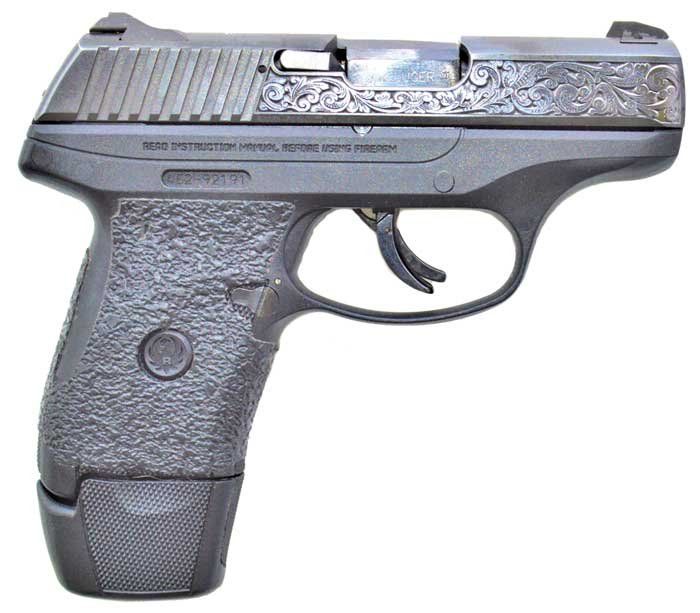
The Ruger LC9s narrowly missed being the Best Buy. This was a good handgun with a couple of touches that take it beyond Ruger’s usual utilitarian fare.
Action Type |
Short recoil-operated locked breech, striker fired |
Overall Length |
6.0 in. |
Overall Height |
4.6 in. |
Maximum Width |
0.9 in. |
Weight Unloaded |
17.0 oz. |
Weight Loaded |
19.8 oz. |
Slide |
Forged alloy steel, blued |
Slide Retraction Effort |
19.0 lbs. |
Receiver Material |
Black glass-reinforced nylon |
Front Strap Height |
2.1 in. |
Back Strap Height |
2.75 in. |
Barrel |
3.12 in. long, blued steel, 6 grooves, |
1:10 RH twist; loaded-chamber inspection port |
|
Grip Thickness (Maximum) |
0.875 in. |
Grip Circumference |
5.0 in. |
Grip |
Checkered |
Magazine |
(1) 7 round |
Rear Sight |
Drift adjustable, two dots |
Front Sight |
Dovetail post, one dot |
Sight Radius |
4.5 in. |
Trigger Pull Weight |
6.0 lbs. |
Trigger Span |
2.8 in. |
Safety |
Trigger lever, frame-mounted lever |
Warranty |
None written |
Telephone |
(336) 949-5200 |
Website |
Ruger.com |
Made In |
USA |
This was a recent price at BudsGunShop.com, for the handgun with one magazine. We added a second magazine, making the all-in price $485. In comparison, a standard Ruger LC9s was only $296 from the same retailer, so this distributor exclusive (TALO) commands quite a premium.
The Ruger LC9s is a striker-fired version of the original Ruger LC9, which was a hammer-fired handgun. The LC9s is a relatively thin handgun, similar to the smaller and popular LCP 380 ACP. While the owner must decide if the extra $141 for engraving is worthwhile, we occasionally like to test and evaluate a customized or special-edition handgun. The LC9s tested is the personal handgun of one of the raters, and he added Talon grip tape ($18, TalonGunGrips.com), as he often does to his polymer-frame handguns, after we had done the preliminary testing of the base model. The Talon grip wrap was well worth its price.

It was less of a pleasure to order a spare magazine for the LC9s ($30 for a 9-round extended magazine, at BudsGunShop.com), which we thought necessary because the LC9s was supplied with a single magazine. These magazines are reliable, but they were very difficult to load with a ninth round, so we counted the magazines as 8-rounders. The less expensive Beretta APX carry is supplied with two mags, and the Bullpup with four, so the Ruger fell behind in value as a consequence.
The Ruger features good sights and a relatively smooth trigger action. The trigger breaks at 6.0 pounds, clean, with minimal take up. The slide and frame are relatively thin. The magazine release and slide lock are positive in operation. The pistol features a manual safety. We really like this for carry close to the body, and the lever operated as expected, but we found it was more difficult to place on Safe. It locked with a solid click. Moving the safety to the Fire position wasn’t difficult, and the safety fell under the shooter’s thumb easily.
Moving the hammer from the frame and a striker into the slide makes for an easier-shooting pistol over the original LC9. The trigger action is very good and provided good results on the firing range. The sights are good to excellent. Notably, in a previous match-up, the Ruger LC9s outperformed the Beretta Nano by a margin. This time, the new Beretta APX Carry gave a better showing, and while the APX is larger than the Nano, the change isn’t much, but the sights and slide lock of the APX Carry make it a better choice than the Nano. In combat shooting, the APX Carry was more controllable and exhibited tighter X-ring placement than the other two handguns.
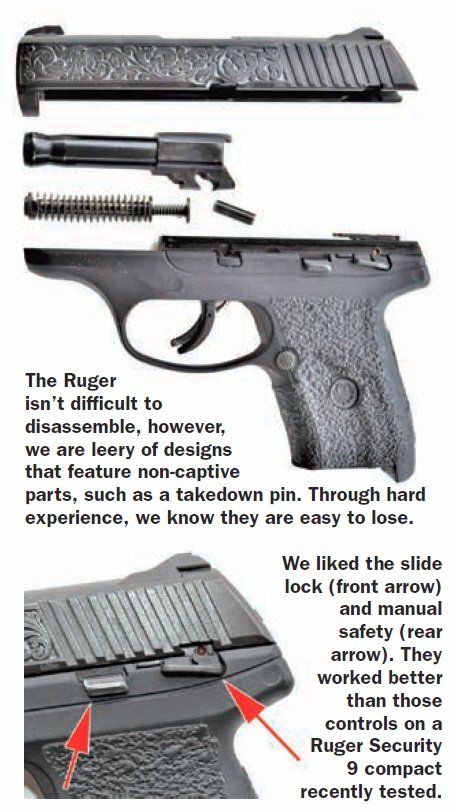
The Ruger was the only pistol tested that features a manual safety. This was more important to some shooters than others. The thumb safety was unobtrusive, positive in operation, and may be activated easily. It featured good indent, so it will not slip off easily. It fell under the thumb when taking a natural firing grip.
The Ruger’s takedown, accomplished by depressing a bar on the left side of the frame and removing a pin, was simple enough to do. However, this takedown isn’t as simple as on other handguns. In this set, the Ruger is easier than the Bond Arms handgun to reassemble. The Beretta demanded a pin in the frame be moved counterclockwise, but it remained captive in the handgun. So, these handguns do not have a big-gun-easy-takedown sequence.
At the range, the Ruger exhibited the least velocity of the three handguns. This isn’t significant, but it was worth mentioning and was certainly a consideration in rating.
Our Team Said: The pistol is thin, and in our experience, was a very concealable handgun. There were no malfunctions or failures to feed of any type during the test. The pistol was fired from the benchrest with the three loads from Winchester, Federal, and Black Hills Ammunition. Accuracy was more service grade than pocket-pistol grade. The Ruger LC9s gave good performance and offers real utility for personal defense.


























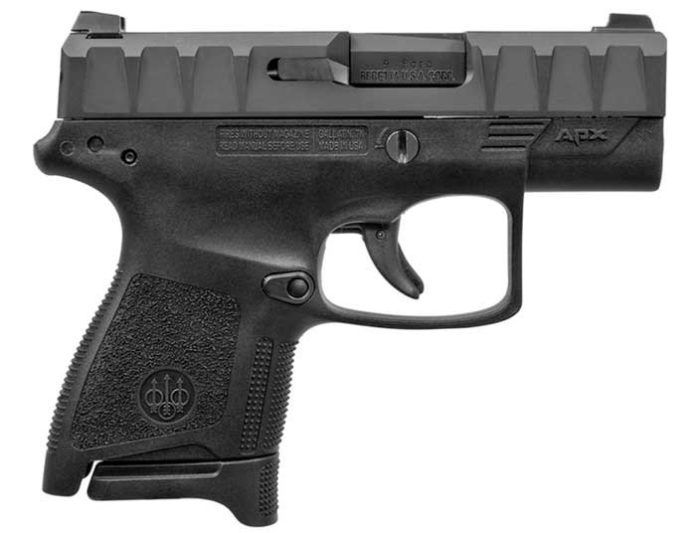




Thanks for fixing our log on issue ! Kevin Cone